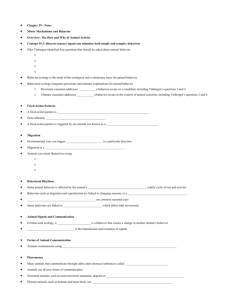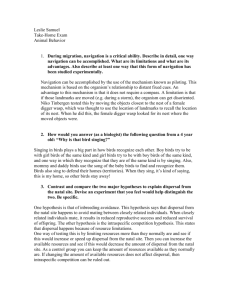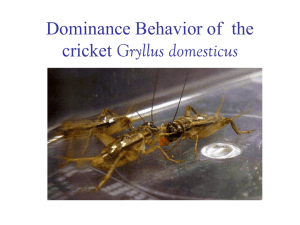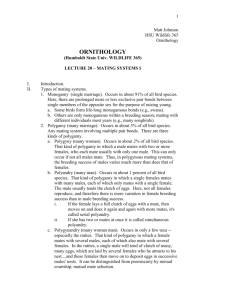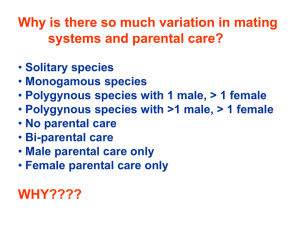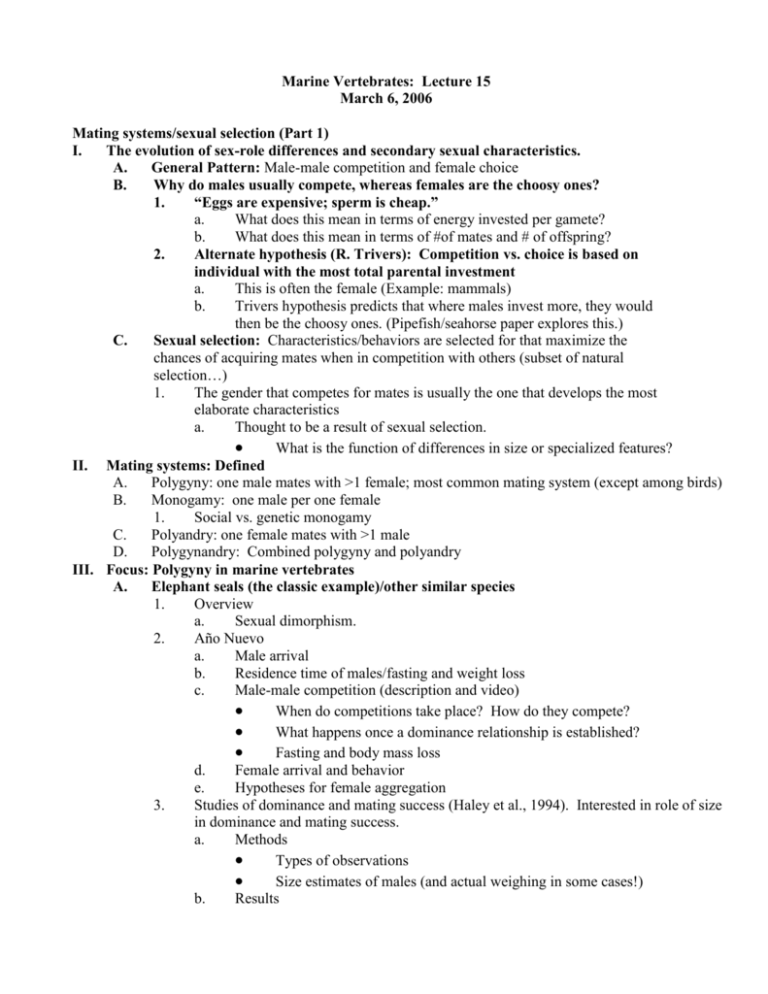
Marine Vertebrates: Lecture 15
March 6, 2006
Mating systems/sexual selection (Part 1)
I.
The evolution of sex-role differences and secondary sexual characteristics.
A.
General Pattern: Male-male competition and female choice
B.
Why do males usually compete, whereas females are the choosy ones?
1.
“Eggs are expensive; sperm is cheap.”
a.
What does this mean in terms of energy invested per gamete?
b.
What does this mean in terms of #of mates and # of offspring?
2.
Alternate hypothesis (R. Trivers): Competition vs. choice is based on
individual with the most total parental investment
a.
This is often the female (Example: mammals)
b.
Trivers hypothesis predicts that where males invest more, they would
then be the choosy ones. (Pipefish/seahorse paper explores this.)
C.
Sexual selection: Characteristics/behaviors are selected for that maximize the
chances of acquiring mates when in competition with others (subset of natural
selection…)
1.
The gender that competes for mates is usually the one that develops the most
elaborate characteristics
a.
Thought to be a result of sexual selection.
What is the function of differences in size or specialized features?
II. Mating systems: Defined
A.
Polygyny: one male mates with >1 female; most common mating system (except among birds)
B.
Monogamy: one male per one female
1.
Social vs. genetic monogamy
C.
Polyandry: one female mates with >1 male
D.
Polygynandry: Combined polygyny and polyandry
III. Focus: Polygyny in marine vertebrates
A.
Elephant seals (the classic example)/other similar species
1.
Overview
a.
Sexual dimorphism.
2.
Año Nuevo
a.
Male arrival
b.
Residence time of males/fasting and weight loss
c.
Male-male competition (description and video)
When do competitions take place? How do they compete?
What happens once a dominance relationship is established?
Fasting and body mass loss
d.
Female arrival and behavior
e.
Hypotheses for female aggregation
3.
Studies of dominance and mating success (Haley et al., 1994). Interested in role of size
in dominance and mating success.
a.
Methods
Types of observations
Size estimates of males (and actual weighing in some cases!)
b.
Results
B.
C.
D.
Which males were most successful (focus on dominance hierarchy)?
Describe the skew in mating success
Did size matter?
What else mattered for male success?
There was no correlation between size and success if dominance was
factored out? What does this mean?
4.
Costs to females (elephant seals and monk seals)
a.
Young may be squashed during mating
b.
Females may be injured by low ranking males
Why?
What do they do to minimize this type of injury?
Are these sneakers likely to be successful? Explain.
c.
Monk seal deaths (Dr. Tatiana, p. 108)
Focus: alternate male strategies (see Bass, 1996)
1.
Plainfin midshipmen
a.
Type I strategy
b.
Type II strategy
2.
Salmon
a.
Jacks, precocious parr and humpies
Defined/differences among the three types
Who do the females choose? (Include controversial new evidence!)
Female to male sex reversal
1.
California sheephead
a.
Harem system described
b.
Behavioral control of sex reversal
c.
Adaptive value of sex reversal: the size advantage hypothesis
Other examples/variations on polygyny
1.
Marine iguanas (Wikelski et al., 2001)
a.
Male behavior/lekking and territories
b.
Female behavior
c.
How doe females choose?
d.
How successful are different males?
e.
What is the alternate mating strategy of non-territorial males (Dr. Tatiana!)
2.
Sperm whales
a.
Overview
b.
Operational sex ratios
c.
Evidence for male-male competition
d.
Female synchrony
Suggested as a way to limit time the bulls are associated with the pod and
therefore disrupt normal activities (i.e. foraging)
3.
Humpback whales
a.
Overview
b.
Operational sex ratios
c.
Male behavior
d.
Female behavior
e.
Results of paternity studies of humpback whales (Cerchio et al., 2005)
References
Bass A, 1996. Shaping Brain Sexuality. American Scientist 84: 352-363.
Cerchio S et al., 2005. Paternity in humpback whales Megaptera Novaeangliae: assessing polygyny and
skew in male reproductive success. Animal Behavior 70 : 267-277.
Haley et al., 1994. Size, dominance and copulatory success in male northern elephant seals, Mirouga
angustirostrus. Animal Behavior 48: 1249-1260.
Judson O., 2002. Dr. Tatiana’s Sex Advice to All Creation. Henry Holt and Co.: New York, 308 pages.
Reynolds JE III, Rommel SA, 1999. Biology of Marine Mammals. Smithsonian Institution Press:
Washington D.C., 578 pages.
Wikelski et al., 2001. Why is female choice not unanimous? Insights from costly mate sampling in marine
iguanas. Ethology 107: 623-638.


